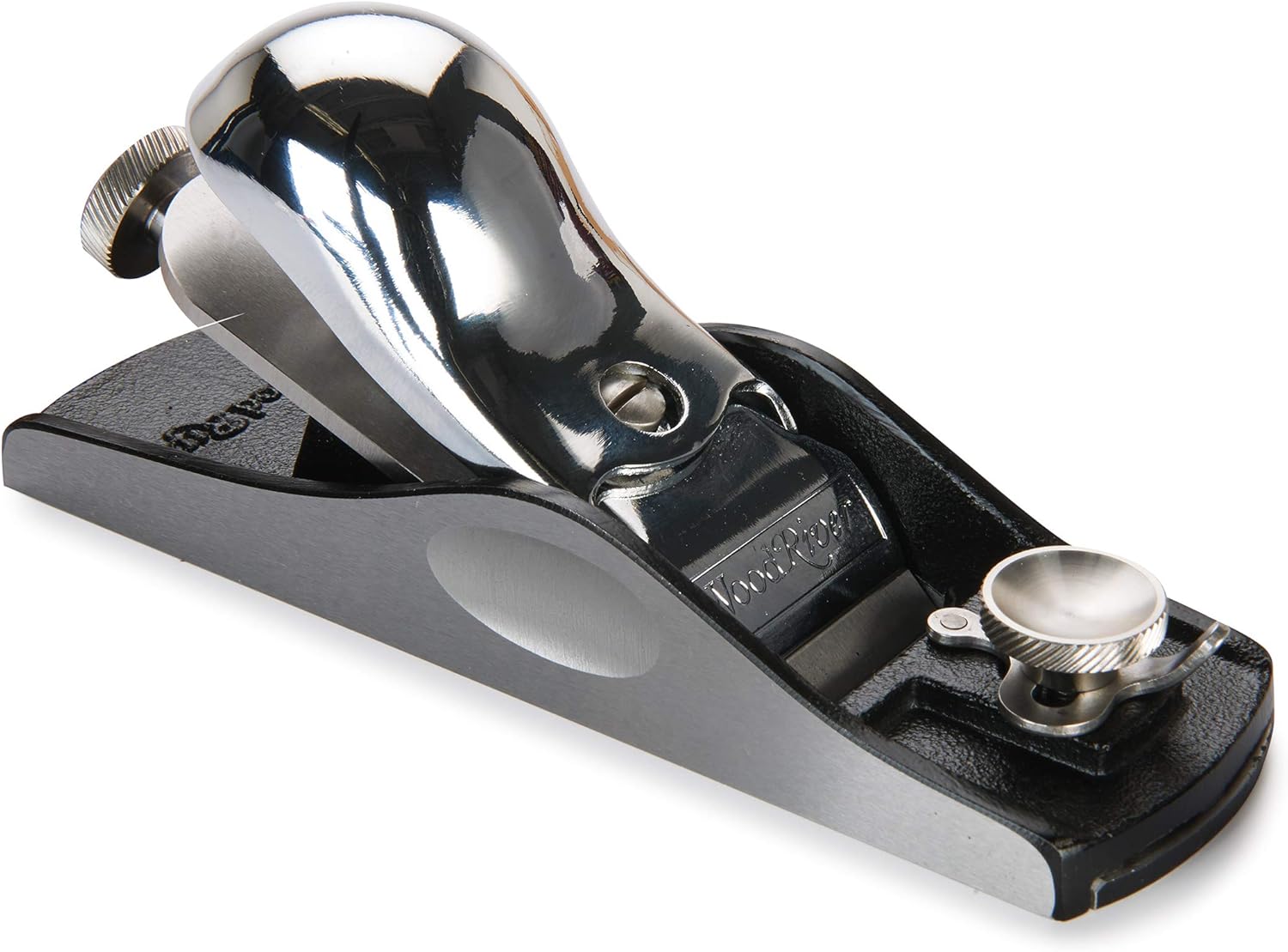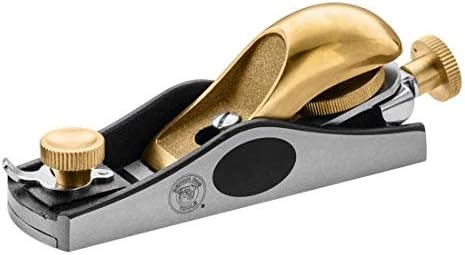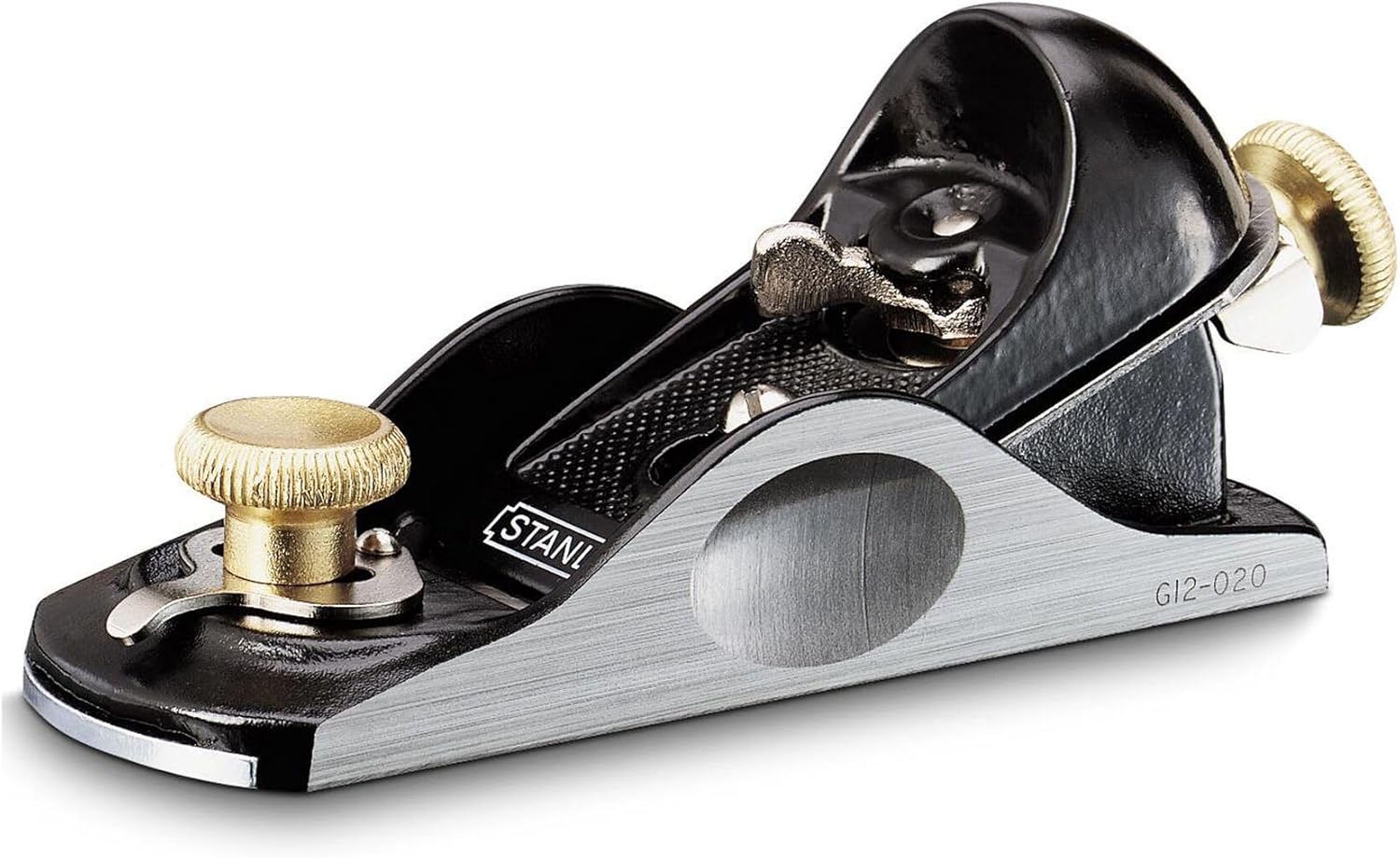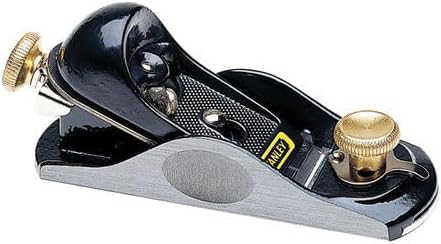Block Planes for Woodworking in 2026
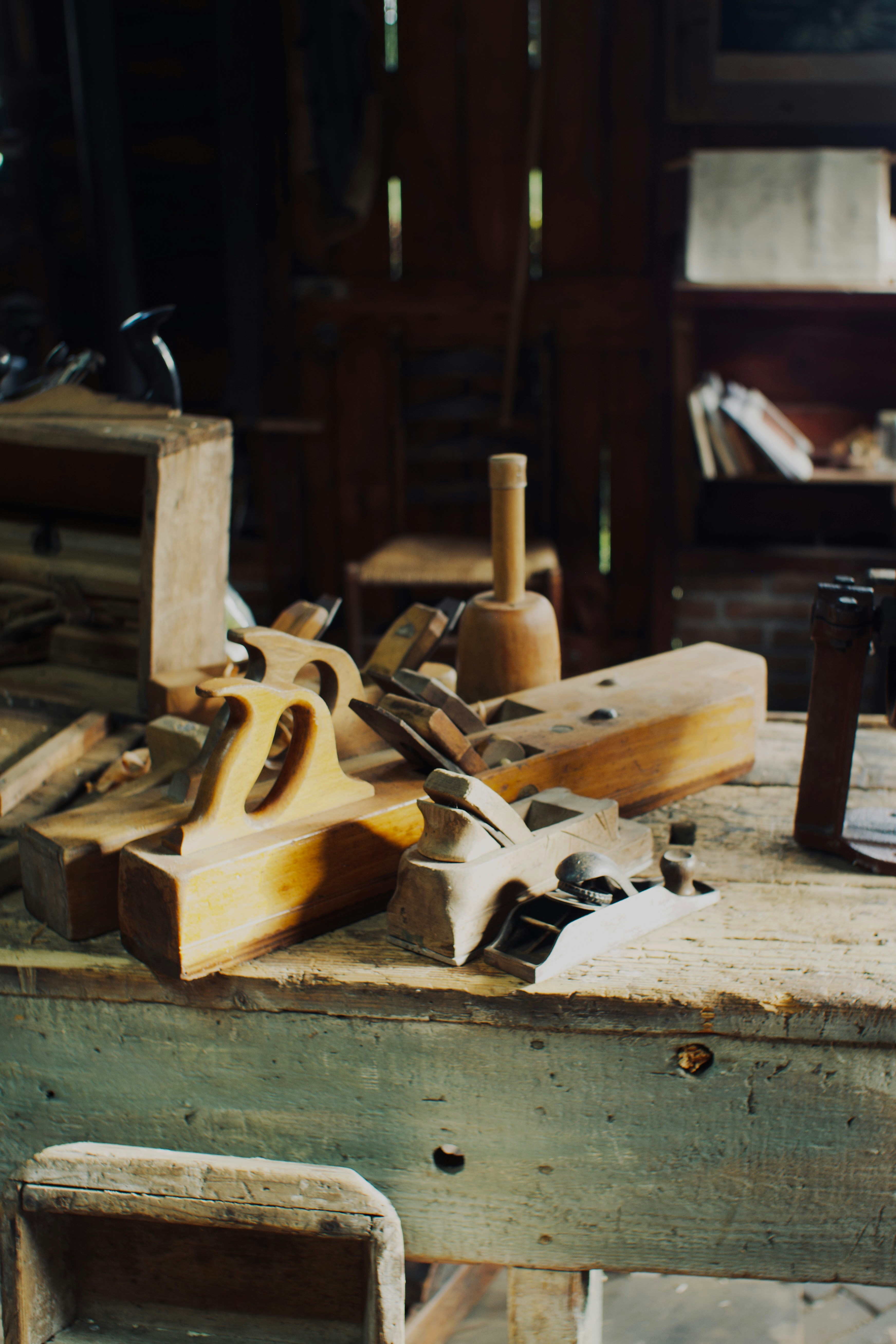
Walk into any working shop and you'll find a block plane within arm's reach. Not tucked away in a drawer, not sitting pristine on a shelf. These compact planes live on benches, in aprons, clipped to belts because they handle the constant stream of small adjustments that happen between the big operations.
The blade sits bevel-up at a low angle, typically between 12 and 21 degrees, which creates a slicing action through end grain that other planes struggle with. That's the mechanical reality that makes block planes different. One hand controls the whole tool, the other steadies the workpiece, and you can chamfer an edge or flush-trim a dowel without repositioning anything in the vise.
What Distinguishes Block Planes
The bevel-up blade orientation creates a fundamentally different cutting geometry than bench planes. Where a bench plane positions its blade at 45 degrees bevel-down, a standard block plane combines a 20-degree bed angle with a 25-degree blade bevel for a 45-degree effective cutting angle. Drop that bed to 12 degrees and you get a low-angle block plane with a 37-degree attack that slices through end grain with less resistance.
The compact body, usually 6 to 7 inches long, means the sole rides surface variations rather than bridging them. That's exactly what you want for spot work. A jack plane or jointer would skip over small areas, but a block plane follows the immediate surface contour and removes material right where you point it.
Weight matters here in ways it doesn't with two-handed planes. Too light and the tool chatters on dense wood. Too heavy and your wrist fatigues after twenty minutes of trimming. The planes that see daily use tend to land between 1.5 and 2.5 pounds, enough mass for momentum without becoming a burden.
Standard Angle vs Low Angle
The bed angle determines what the plane cuts well. Standard angle block planes (20-degree bed) with their 45-degree effective cutting angle handle long grain and general smoothing work. The same geometry found in bench planes translates to similar cutting characteristics, just in a more compact package.
Low-angle versions (12-degree bed) excel at end grain because that 37-degree cutting angle approaches the fibers more tangentially. Less resistance means cleaner cuts across growth rings. Cabinetmakers cutting dovetails or fitting drawers reach for low-angle planes first because that's where end grain trimming happens most.
The adjustable mouth on either configuration controls tearout by supporting wood fibers right at the cutting edge. Open it up for heavy stock removal, close it down when figured grain threatens to tear out. The mechanism itself just moves the front casting forward or back, changing how much open space exists in front of the blade.
Block Planes Worth Considering
The planes that show up in working shops fall into distinct categories based on how they're built and what they cost. Some arrive ready to cut, others need setup work. The market reflects this spectrum.
WoodRiver Standard Block Plane
20-degree bed angle
1-5/8" blade (0.125" thick)
2" wide × 7" long body
2.24 pounds
High carbon steel blade hardened to Rc60-64
The knuckle-style lever cap makes a visual statement, but the blade thickness and heat treatment matter more for actual cutting. At 0.125 inches thick, the blade resists flexing under pressure. The hardness rating means the edge holds longer between sharpenings, though it also means the steel takes more effort to hone.
The adjustable mouth moves smoothly without tools. Depth adjustment happens via the rear knob, lateral adjustment through the lever. The casting quality determines how well these mechanisms hold settings under cutting pressure. Ductile iron castings stay flat and square if properly stress-relieved during manufacturing.
Bench Dog No. 60-1/2 Low Angle Block Plane
12-degree bed angle (low angle configuration)
1/8" thick blade
One-piece frog and base casting
Comes with storage case and plane sock
Certificate of inspection with flatness measurements
The acute bedding angle creates that 37-degree cutting angle that slices end grain cleanly. The one-piece frog casting eliminates a common source of chatter since there's no separate frog that can work loose or sit imperfectly on the base.
Including actual flatness measurements with each plane means someone checked the sole with precision equipment. That documentation tells you what tolerance you're working with rather than hoping the casting came out flat. The plane sock and storage case matter for keeping the blade protected between uses.
Stanley 1-12-020 Block Plane No. 9
21-degree blade angle
7.87" long × 2.76" wide
1.92 pounds
Cast iron construction
Stanley's numbering system dates back to the Bailey patent era, and the No. 9 designation indicates a standard angle block plane configuration. The 21-degree angle sits between typical 20-degree standard blocks and 12-degree low-angle versions, creating a middle ground that works for cross-grain and end-grain applications.
The weight distribution at 1.92 pounds puts it on the lighter end of working block planes. Less mass means more control for delicate work but potentially more effort when planing dense hardwoods where momentum helps maintain consistent cutting depth.
Stanley 12-920 Contractor Grade Block Plane
21-degree cutter angle
6-1/4" long
1-5/8" cutter width
8.32 ounces
Quick-release cam lock
Machined finger grips
The contractor grade designation signals this plane sits in Stanley's value tier. At 8.32 ounces, it weighs roughly half what the heavier cast planes do. That lightness shows up in single-handed use, where fatigue matters more than momentum.
The quick-release cam lock speeds blade removal for sharpening. Rather than backing out adjustment screws, you flip the cam and lift the blade free. The machined finger grips on the sides provide purchase points for one-handed control, though the light weight means maintaining downward pressure requires deliberate technique.
The epoxy coating on the base provides corrosion protection. Cast iron rusts readily in humid shop environments, so any barrier between metal and moisture extends tool life.
Stanley 12-960 Contractor Grade Low Angle Plane
13.5-degree bed angle
6" long
1-3/8" cutter width
1.6 pounds
Hardened, tempered tool steel blade
Quick-release cam lock
The 13.5-degree bed creates a low-angle configuration that targets end grain work specifically. Combined with a standard 25-degree blade bevel, the effective cutting angle comes out to 38.5 degrees, right in the sweet spot for slicing across wood fibers rather than pushing through them.
At 1.6 pounds, this plane sits between the ultra-light contractor models and heavier precision castings. The weight provides enough momentum for consistent cuts without becoming tiring during extended trimming sessions.
The narrower 1-3/8 inch cutter width means less blade surface contacting the wood, which translates to less cutting resistance. That matters most when working narrow stock like drawer sides or small box parts where a wider plane would overhang the workpiece edges.
Stanley 12-220 Hand Planer
21-degree blade angle
Cast iron base with machined sides
Fully adjustable depth and alignment
Epoxy resin coating
Finger rest on front knob
This sits at Stanley's entry price point for functional block planes. The cast iron base with machined sides means the critical surfaces that contact the workpiece and support the blade received finishing operations rather than being left as-cast.
The finger rest molded into the front knob provides a purchase point for downward pressure. Block plane technique typically involves pressing down with the index finger near the mouth while the palm drives the rear handle forward. That forward finger placement matters more for control than the rear hand position.
Full adjustability at this price point means both depth and lateral adjustment mechanisms are present. Budget planes sometimes eliminate the lateral adjuster, requiring manual blade positioning by tapping the blade sideways with a hammer.
Sole Flatness and Why It Matters
The sole serves as the reference surface that rides the workpiece. Any deviation from flat creates corresponding errors in the planed surface. A convex sole (high in the middle) won't cut at all in the center. A concave sole (low in the middle) creates a rounded cut that gets deeper in the middle than at the edges.
Premium planes like Lie-Nielsen and Veritas machines come lapped flat within 0.001 inches. Mid-range planes typically arrive within 0.003 to 0.005 inches. Budget planes might show 0.010 inches or more variation. That spread determines whether the plane works immediately or requires flattening work before it cuts properly.
Checking sole flatness requires a known-flat reference surface and a straightedge. Machine tables work if they're actually flat. Granite surface plates provide reliable references. The straightedge reveals gaps when laid across the sole in various orientations.
Flattening a sole means lapping it on abrasive paper adhered to that flat reference. Start with 80-grit to remove material quickly, progress through 150, 220, and 400-grit to refine the surface. The time investment varies from fifteen minutes for nearly-flat soles to several hours for badly warped castings.
Blade Thickness and Chatter
Block planes lack the chipbreaker that stiffens bench plane blades. The blade cantilevers out from the frog with nothing supporting it near the cutting edge. That unsupported length means blade rigidity comes entirely from material thickness and heat treatment.
Thin blades (0.080 to 0.100 inches) flex under cutting pressure, creating chatter that leaves washboard ripples in the planed surface. The vibration also dulls the edge faster since the cutting edge impacts the wood at varying depths rather than maintaining consistent engagement.
Thicker blades (0.125 to 0.160 inches) resist flexing, maintaining steady cutting geometry even when removing heavy shavings. The mass also dampens vibration transmitted through the plane body. Premium planes typically specify blade thickness in their technical specs because it correlates directly with cutting performance.
The hardness of the blade steel matters almost as much as thickness. Soft steel flexes more than hard steel of the same thickness. Hardness ratings (Rockwell C scale) between 58 and 62 indicate properly heat-treated tool steel that balances edge retention against sharpening difficulty.
Mouth Adjustment Mechanisms
The mouth opening determines how much space exists between the front of the blade and the forward edge of the mouth. Closing the mouth supports wood fibers closer to the cutting edge, reducing tearout in figured or cross-grained wood. Opening the mouth allows thicker shavings to pass through without clogging.
Fixed-mouth planes set that opening at the factory. The only adjustment involves moving the blade forward or back, which changes the effective mouth opening indirectly. These simpler mechanisms have fewer parts to misalign or work loose.
Adjustable-mouth planes include a moveable front section (the toe casting) that slides forward to close the mouth or backward to open it. A lever or knob controls the adjustment. This added complexity provides cutting versatility but creates potential for the mechanism to shift under cutting pressure if not properly designed.
The mouth opening itself typically ranges from 0.015 inches (closed) to 0.080 inches (fully open). Fine finishing cuts with difficult grain want the tightest opening. Rapid stock removal or chamfering operations work better with wider openings that clear shavings quickly.
What Block Planes Actually Get Used For
End grain trimming tops the list. Fitting drawer fronts, cleaning up dovetail pins, flushing through-tenons—all involve cutting across growth rings where regular bench planes tear and chip. The low cutting angle and compact size make block planes the default tool for these operations.
Chamfering edges happens constantly in woodworking. Breaking sharp corners prevents splinters and softens the visual transition between surfaces. A few passes with a block plane creates consistent chamfers faster than setting up a router.
Fitting doors and drawers requires removing small amounts of material from specific spots. Trying to plane an assembled door with a bench plane creates awkward body positions. A block plane works from any angle, removing material exactly where binding occurs.
Leveling proud joinery shows up in hand-cut work. Dovetail tails standing above the surface, dowels extending past the surrounding wood, through-tenons requiring flush trimming—the block plane handles all these spot-planing tasks without disturbing surrounding areas.
Smoothing small parts doesn't require a smoothing plane. Anything small enough to hold in one hand while planing gets tackled with a block plane. Box sides, drawer parts, small brackets—the compact tool matches the scale of the work.
The Market Reality
Lie-Nielsen and Veritas dominate the premium tier with bronze-bodied planes featuring thick blades (0.155 inches) and precision-machined soles. These planes cost $150 to $300 but work immediately without setup. The sole flatness, blade quality, and fit of moving parts justify the price for woodworkers doing production work or hand-tool-intensive projects.
WoodRiver occupies the mid-market with planes priced around $100. These use cast iron rather than bronze but still feature thick blades and adjustable mouths. Sole flatness varies more than premium planes, so some checking and potential lapping may be necessary. The mechanisms generally work smoothly if properly assembled at the factory.
Stanley contractor grade planes hit the $20 to $40 range. At this price, expect to flatten the sole yourself and possibly tune up the blade. The light weight and simpler castings mean these planes work best for occasional use rather than production environments. They're functional tools that require more user involvement to achieve good results.
Vintage Stanley planes from the 1950s and earlier often exceed modern contractor grade quality despite lower prices on the used market. A Type 15 or Type 16 Stanley from the WWII era might cost $30 to $50 and provide better casting quality than current production models. The trade-off involves hunting for good examples and potentially cleaning up rust and grime.
Related Hand Planes
Block planes handle specific tasks within a larger hand plane ecosystem. Understanding what other planes do helps clarify when to reach for the block plane versus alternatives.
Low angle jack planes bridge the gap between block planes and full-sized bench planes. The 14-inch length flattens edges and surfaces while the low angle handles end grain. These work well as first-plane purchases since they cover multiple operations adequately.
Shoulder planes excel at trimming tenon cheeks and rabbets. The blade extends to the full width of the body, allowing cuts right into corners. Where block planes handle general end-grain work, shoulder planes tackle joinery precision.
The complete range of hand plane types spans from tiny 3-inch chisel planes to 24-inch jointer planes. Each length and configuration serves specific operations in the progression from rough stock to finished surfaces.
Understanding plane blade geometry clarifies why different planes cut differently. The bevel angle, bed angle, and blade thickness all combine to determine cutting characteristics and the types of work each plane handles well.
Block planes carve out their niche by being compact, maneuverable, and optimized for the cross-grain cutting that happens constantly in woodworking. The low cutting angle and one-handed control make them indispensable for the stream of small adjustments and finishing touches that occur between the major operations. Every working shop has at least one within arm's reach.
